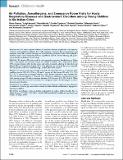| dc.contributor.author | Orazzo, Flavia | |
| dc.contributor.author | Nespoli, Luigi | |
| dc.contributor.author | Ito, Kazuhiko | |
| dc.contributor.author | Tassinari, Davide | |
| dc.contributor.author | Giardina, Daniela | |
| dc.contributor.author | Funis, Maurizio | |
| dc.contributor.author | Cecchi, Alessandra | |
| dc.contributor.author | Trapani, Chiara | |
| dc.contributor.author | Forgeschi, Gisella | |
| dc.contributor.author | Vignini, Massimo | |
| dc.contributor.author | Nosetti, Luana | |
| dc.contributor.author | Pigna, Sabrina | |
| dc.contributor.author | Zanobetti, Antonella | |
| dc.date.accessioned | 2010-11-22T16:05:41Z | |
| dc.date.issued | 2009 | |
| dc.identifier.citation | Orazzo, Flavia, Luigi Nespoli, Kazuhiko Ito, Davide Tassinari, Daniela Giardina, Maurizio Funis, Alessandra Cecchi, et al. 2009. Air pollution, aeroallergens, and emergency room visits for acute respiratory diseases and gastroenteric disorders among young children in six Italian cities. Environmental Health Perspectives 117(11): 1780-1785. | en_US |
| dc.identifier.issn | 0091-6765 | en_US |
| dc.identifier.uri | http://nrs.harvard.edu/urn-3:HUL.InstRepos:4584708 | |
| dc.description.abstract | Background: Past studies reported evidence of associations between air pollution and respiratory symptoms and morbidity for children. Few studies examined associations between air pollution and emergency room (ER) visits for wheezing, and even fewer for gastroenteric illness. We conducted a multicity analysis of the relationship between air pollution and ER visits for wheezing and gastroenteric disorder in children 0–2 years of age. Methods: We obtained ER visit records for wheezing and gastroenteric disorder from six Italian cities. A city-specific case–crossover analysis was applied to estimate effects of particulate matter (PM), nitrogen dioxide, sulfur dioxide, ozone, and carbon monoxide, adjusting for immediate and delayed effects of temperature. Lagged effects of air pollutants up to 6 prior days were examined. The city-specific results were combined using a random-effect meta-analysis. Results: CO and SO2 were most strongly associated with wheezing, with a 2.7% increase [95% confidence interval (CI), 0.5–4.9] for a 1.04-μg/m3 increase in 7-day average CO and a 3.4% (95% CI, 1.5–5.3) increase for an 8.0-μg/m3 increase in SO2. Positive associations were also found for PM with aerodynamic diameter ≤ 10 μg and NO2. We found a significant association between the 3-day moving average CO and gastroenteric disorders [3.8% increase (95% CI, 1.0–6.8)]. When data were stratified by season, the associations were stronger in summer for wheezing and in winter for gastroenteric disorders. Conclusion: Air pollution is associated with triggering of wheezing and gastroenteric disorders in children 0–2 years of age; more work is needed to understand the mechanisms to help prevent wheezing in children. | en_US |
| dc.language.iso | en_US | en_US |
| dc.publisher | National Institute of Environmental Health Sciences | en_US |
| dc.relation.isversionof | doi:10.1289/ehp.0900599 | en_US |
| dc.relation.hasversion | http://www.ncbi.nlm.nih.gov/pmc/articles/PMC2801171/pdf/ | en_US |
| dash.license | LAA | |
| dc.subject | air pollution | en_US |
| dc.subject | asthma in children | en_US |
| dc.subject | epidemiology of asthma | en_US |
| dc.subject | children’s health | en_US |
| dc.title | Air Pollution, Aeroallergens, and Emergency Room Visits for Acute Respiratory Diseases and Gastroenteric Disorders among Young Children in Six Italian Cities | en_US |
| dc.type | Journal Article | en_US |
| dc.description.version | Version of Record | en_US |
| dc.relation.journal | Environmental Health Perspectives | en_US |
| dash.depositing.author | Zanobetti, Antonella | |
| dc.date.available | 2010-11-22T16:05:41Z | |
| dash.affiliation.other | SPH^Exposure Epidemiology and Risk Program | en_US |
| dc.identifier.doi | 10.1289/ehp.0900599 | * |
| dash.authorsordered | false | |
| dash.contributor.affiliated | Zanobetti, Antonella | |


